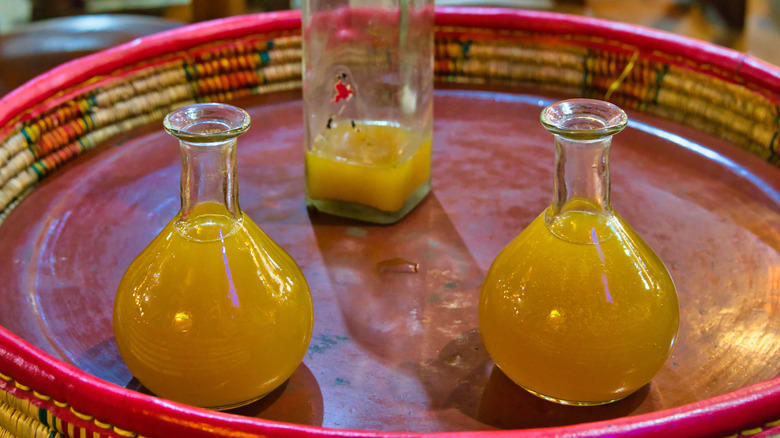Tej: The Ethiopian Honey Wine With Ancient Origins
When you're thinking about wine, the first fruit that comes to mind is probably grapes. Many of you may be familiar with the viral Grape Lady meme, which features an overenthusiastic reporter slipping while stomping grapes and subsequently letting loose a torrent of grunts on the ground. The viral superstar could've avoided her misfortune if she explored the wide world of non-grape winemaking.
Over time, folks have found that grapes have the best balance of acidity and sweetness to make delicious wine, but that doesn't mean other fruits, and even other pieces of produce, cannot be turned into a pleasant drink. Lesser-known wines include carrot, dandelion, and maple concoctions. If you make berry wine, you will need to be cautious of the berries' intense acidity, and add extra water. Other fruits, like watermelon and pear, will need an acid infusion to become a palatable wine. A Peruvian farmer in the Andes made wine from sugary potatoes. In Ethiopia, people have been brewing a honey-based drink called tej for thousands of years.
The history of tej
Tej is a type of fermented honey wine. It is technically classified as mead, which is a term that refers to a wide variety of honey wines that have emerged from different historic civilizations. Tej is similarly ancient, and has, by most accounts, been being brewed and enjoyed in Ethiopia for thousands of years.
Like most meads, the ingredients of tej include honey, water, and yeast. Tej also includes gesho leaves, a waxy green leaf that is in the same family as hops, the bitter bud used to give beer its trademark bitterness.
Tej is most commonly served in bereles, which are glass beakers with long, skinny necks — when paired with the drink's vibrant orange hue, the tej experience seems almost sci-fi. While traditional tej recipes all call for essentially the same list of ingredients, there is still an incredible amount of variation between batches of the beverage. Your beaker could have an ABV of as much as 40%, the same concentration that vodka has if the tej it contains has been fermenting for long enough. Some tej is strong and funky, while some are meek and mild.
The culture of tej bet
First brewed thousands of years ago, tej is still a staple drink in Ethiopia. When tej first emerged, it was reserved for the wealthy, but it has since become a universal beverage, and tej bets, where people can gather and throwback beakers of honey wine, can be found all around Ethiopia. A beaker of tej costs around 17¢, so anyone can sip comfortably nowadays. The names of these bars are also modernized. You can sip tej at the Gedel Gibu Tej Bet, which essentially translates to a "go to hell" bar, or get your drink on at the Obama Tej Bet, named for President Obama.
In terms of tej quality and flavor, there is much in the way of uniformity across the tej bets. Certain establishments brew vats of long-fermented, powerfully pungent tej, but if you want something sweeter, it's entirely possible that the tej bet across the street will be serving something sweeter.
The culture of tej bets in Ethiopia is still shaped by strict gender guidelines. When Austin Bush of the Los Angeles Times visited Berkay Tej Bet, a drinking spot in Lalibela, Ethiopia. While enjoying beakers of honey wine, Bush learned from the tej bet's owner, Berkay, that the tej bet of Lalibela is almost exclusively owned by women. However, when Bush spoke with a local Christian Orthodox priest, he found that women aren't allowed to patronize the drinking establishments, under threat of social ostracization.


